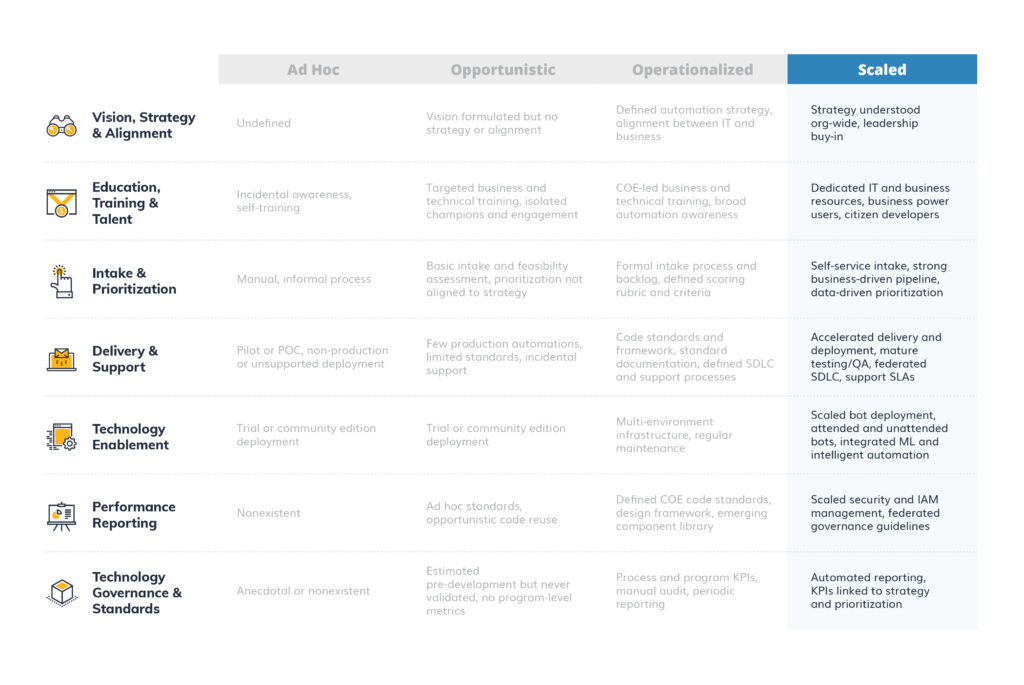As we continue our enterprise automation blog series, we discuss how a center of excellence can help you scale your automation program.
If you’ve been following along with this blog series, then you know automation is a powerful way to improve your organization’s efficiency and effectiveness.
An operationalized automation program can help you achieve your strategic goals more quickly, make better decisions and provide better customer service. But as your automation program matures, it can be hard to keep track of all the different parts — and make sure everything stays aligned with your overall strategy.
That’s why it’s important to have a plan in place that helps you scale your automation program effectively. Like an overgrown yard full of unruly grass, weeds, trees and shrubbery, an automation program lacking a well-developed plan will quickly overwhelm an organization. If you’re looking for guidance on how to strategically scale your lawncare efforts, we will “leaf” that to you. But if your concern is enterprise automation, we’ve got you covered. Below are some things to consider when scaling your automation program.
Organization
Driving Vision, Strategy and Alignment with a Center of Excellence
In the operationalized stage we focused heavily on showing the benefits of a center of excellence (COE) and recommended standing up a COE as the driver for change within your organization. The scaled stage is all about taking the COE to the organization. The COE will help you drive your automation program forward by providing:
- A centralized place for all parts of the business to connect. Teams can see what is happening across the company, get approvals and provide feedback on their automation efforts. They will also be able to see how their work impacts other teams and vice versa.
- More visibility into your customer experience and quality of service. The COE can collect quality data from each department in the organization, so it’s easier for them to understand where they are performing well and where there may be opportunities for improvement.
Importantly, at this point, you should have alignment from leadership and buy-in at multiple levels of the organization. The COE needs to communicate to these organizational levels, and the teams not directly involved should know when to reach out and how to communicate with the COE.
Education and Training Automation Talent
With automation more embedded in your organization, you may now have enough volume to merit dedicated roles and responsibilities aligned to automation needs. Individuals working together on both technical and business aspects of automation should be a part of the leadership team of the COE. This is important because they provide a natural balance between the business’s desires and the possibilities the technology team brings.
With so many automations and tools running, there may also be a need to add dedicated support resources on any pre-existing IT departments to meet the needs that power users cannot solve. This could take the shape of an automation team member dedicating more of their time to pure support or training help desk users on the basics of the automation programs in the organization.
This is an excellent stage to start building a citizen development program. Citizen developers are non-technical employees who see opportunities for using technology to make their work easier and more efficient. These people might be power users or even subject matter experts (SMEs). Regarding enterprise automation, we highly recommend partnering citizen developers with proven developers who can assist with troubleshooting and providing insight.
Operations
Automation Program Intake and Prioritization
Your organization’s intake, pipeline and prioritization processes should already be fairly mature before sharing with the rest of the organization. Firstly, the intake form should be self-service, and a business analyst, or preferably the SME, can fill it out. This ensures a certain level of quality and helps drive ownership of the submitted items through to completion.
The pipeline backlog should have clear rules you’ve defined and aligned to your organization’s needs and goals. These rules should include ROI policies for new automations, and the COE should review these policies regularly. Prioritization should follow a similar ruleset but identify what teams should work on next based on strategic impact.
For example, prioritization models could include putting a higher impact on areas in dire need of automation or deprioritizing short-term teams or teams with less technological capabilities.
Automation Program Delivery and Support
When scaling your automation program, deployments will greatly increase, which means many more go lives, testing requirements managing the software development lifecycle (SDLC) across departments and keeping service level agreements (SLAs). Many automation programs offer ways to accelerate your delivery and deployment. Your internal automation teams shouldn’t shoulder the burden of support alone. Your larger technical organization needs to help.
With multiple environments set up during scaling, you must also identify ways to automatically test large amounts of data with the latest iterations. We recommend regular refreshes of QA environments to match production data, so you keep unknowns away from areas that could affect customers. You should also use automation tools that apply library components regularly. The COE and analysts designing automations should recognize areas where workflows and automations are reusable and build those into a component library. Fully unit testing each library component will help speed up the testing requirements.
Establishing realistic SLAs for the support teams mentioned above builds confidence in the automations, further expanding the automation program’s success. These successes can allow you to further integrate automations into disparate systems and teams. When you gain a controlled flow of information, integration and development, you can build on a federated architecture where components can act independently or as part of the larger end-to-end business processes.
Enablement
Technology Enablement
At this point in your enterprise automation maturity, there are already multiple vendors, platforms, or products in your pipeline. Maturely using all these technologies can take your automation from the level of hand-raking piles of leaves to mulching, composting and using them in your garden. Just like moving from merely raking and bagging to composting creates new life from old leaves, scaling your automation program creates new opportunities for inefficient, underperforming business processes.
Today, most companies leave robotic process automation (RPA) bots in production unattended, meaning humans have little or no interaction with the bot outside of exception handling. However, there are many use cases for attended bots driving small efficiencies for each record but at extremely large volumes. Some quick examples of efficiencies driven by attended bots include formatting spreadsheets, transcribing contact center scripts, compiling documents or downloading large amounts of files.
Artificial intelligence (AI) and machine learning (ML), used in conjunction with automation, can also help users make decisions or process documents. For example, pairing AI with a document intake automation can classify documents and extract the information while giving a confidence level to each field captured as well as the whole document. This alone can speed up processing. If a user were to continue checking every transaction – but with the addition of high confidence levels – now they can automatically input that information.
Automation Program Governance and Standards
With your organization developing all this automation across all areas, you may have problems maintaining security across bots and service accounts. Instead of allowing your automation security to become like the “Wild West,” there are several best practices you can follow. Giving traditional users minimal privileges to accounts is one best practice. We also recommend following the federated model. In a federated approach, separate groups, departments, teams and business units only have access to their appropriate environments, data and systems.
You should also use credential repositories to maintain the many passwords, systems and keys associated with all these accounts. Additionally, having automations or bots that maintain these passwords can keep them up to date and remove the likelihood of passwords expiring or users getting locked out.
Reporting on Automation Performance
The goal of reporting at the scaled stage is to build KPIs linked to the strategy of the automation program and set automatic reporting and notification thresholds. A report should not be something you have to manually refresh. Rather, you should set it up so COE members can view it at a moment’s notice.
Additionally, you need to set up threshold notifications and monitoring to notify key members when there are issues or to help right-size the number of licenses, servers and bots to stay operational. It wouldn’t look great on your COE if a group of new hires couldn’t use their key systems in time simply because the automatic onboarding hadn’t set up their accounts yet. Threshold notifications allow members to quickly step in and remedy such issues – a great example of why reporting is critical – and why automations won’t replace people any time soon.
Conclusion
The scaled stage is all about growth. Going to new teams and business units while setting each area up for success in the larger enterprise. Maintaining governance and standards and reporting on automation performance are crucial to reducing any growing pains along the way. In our final blog in this series, we will wrap up the vision of what a fully optimized automation program looks like and how you can embed it in every part of your organization.


